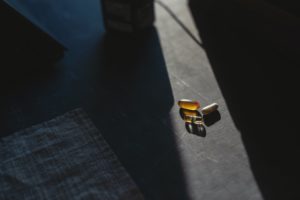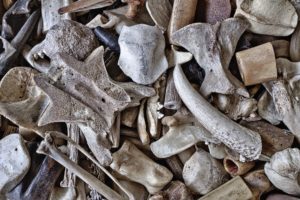There are many ways to build a diet, some better, some worse:
- Some are severely nutrient deficient, as I think of ‘only-meat’ carnivore diets, or plant-based diets.
- Others have the ability to cover the full spectrum of nutrients but can fail in the details. These include animal-based diets or the classic omnivore diet.
In this post, we look at the potential pitfalls, that can occur when constructing an animal-based diet. By this I don’t mean a pure carnivore diet, but one that is seasonally-supplemented by the least harmful plants. By definition, an animal-based, nose-to-tail diet is very nutrient dense. You have most essential vitamins, minerals, and zoonutrients covered.
Nevertheless, you will not be able to cover a few nutrients, if we take the recommendations of the DGE as target values. In individual cases further deficiencies can occur due to bad planning. If you need help with this, I have put together an ebook on all the nutrients for you!
First, we’ll look at the 3 nutrients that the DGE says you definitely won’t meet if you eat animal-based. We’ll also clarify if this is a problem, as these reductionist recommendations are far from optimal in some cases. Next, we’ll also look at conditional risks and how you can simply avert them by eating like your ancestors always did.1Good example: ketogenic metabolism vs. carbohydrate-based, or the highly-inflammatory western diet vs. animal-based diets.
Where do Nutrient Recommendations come from?
Broadly speaking, they are meant to be benchmarks against which nutrition can be measured. The best-known values are the RDA (Recommended Dietary Allowance), AI (Adequate Intake), and UL (Upper Intake Level).2See here for definitions: https://ods.od.nih.gov/HealthInformation/Dietary_Reference_Intakes.aspx First developed by the American authorities, the EU and DACH area also adopted the system, making only minimal adjustments. It is important to know that these are purely statistical values, which are quite accurate, but not perfect – already the developers knew that. Yet still these limitations seem to disappear from the minds of modern people and likewise professionals.3https://de.wikipedia.org/wiki/Recommended_Daily_Allowance#G%C3%BCltigkeit_und_Genauigkeit
For our topic, it is important to know these 3 guys, especially how they came about in the 50s. We’ll look at that after the definitions of the three!
What is the Recommended Dietary Allowance (RDA)?
RDAs are recommendations based on scientific data of various kinds. These data may have been observed purely statistically, others are supported by solid mechanistic data. Nevertheless, it is important to note that all of these are estimated values, for broad populations, and are not set in stone, especially with respect to individuals.

The RDA is defined as the nutrient level at which 97.5% of an observed population consistently across all age groups show no CLINICAL deficiency symptoms.
The RDA is based on another value called Estimated Average Requirement (EAR) which tells you the same thing for 50% of the population. As you can see, some data goes into these values, including mechanistic and interventional, not just epidemiological, of which I am not a fan.4For hypothesis generation yes, but not for confirmation. Epidemiology only gives directions worth investigating more closely. For firm opinions, tangible intervention studies and mechanisms are needed.
To some extent, elimination rates of nutrients are also used. In doing so, the RDA looks at the current population.
What is the Adequate Intake (AI)?
The AI is less strict and mathematically defined than the RDAs.
In plain English it’s an intelligent guess based on statistical data. It is used either because data is missing to establish an RDA or because the data is missing, misleading, or cannot be brought together coherently.
Often AIs ‘happen‘ in the context of trace elements or newer vitamers. The scientific community cannot establish clear toxicity, or symptoms of deficiency. Therefore, it is simply an estimate that must suffice and is based on what the general population is statistically via the standard diet each day. The thought process goes like this: as long as there are no deficiencies or poisonings, it fits. But as you will see, the body is rarely that easy, and guesses remain just that, even if backed up by epidemiology.
What is the Upper Intake Level (UL)?
The Upper Intake Level is the upper limit of a nutrient that you should take daily, usually with a buffer to prevent toxic effects.
The UL is defined as the level at which 97.5% of the population will not develop side effects after ingestion.
Often ULs are great upper limits within which you can plan your daily or weekly nutrient needs. Some substances have huge frames, like iodine at several 10g, some relatively narrow, like vitamin A, if you ever plan to eat polar bear liver.
Big Isses regarding the RDA & AI
The Bulk of the Sample Size is dysfunctional

RDAs & AIs are easy ways to plan nutrition. And that’s exactly what they’re designed for. Even though they are relatively useful, they come with some innate problems. These values are created from the data of the general population over the last few decades and herein lies the first problem:
Most of the population is dysfunctional and sick. It suffers from SUBCLINICAL nutritional deficiencies.
As David Foster Wallace describes so magnificently in his speech, ‘This is Water,’ the water we swim in, the population, is polluted, and we don’t even realize it. The whole health pool is muddy and drawing guidelines from it is just as misleading. The RDAs are based exclusively on people eating the standard diet of the West, high in grains, sugars, plants, pesticides, and all the garbage humans take in like that. Also exclusively carbohydrate based. And we know full well that ketogenic metabolisms work differently in detail.5For example, you need less vitamin C due to ascorbate-glucose antagonism, while the need for thiamine & riboflavin increases by up to 70%.
Solely clinical Deficiencies make it into the Statistics
The second weakness is the fixation on CLINICAL deficiencies.
Clinical deficiencies are at the extreme end of the spectrum, with, for example, beriberi (B1 deficiency), pellagra (niacin), Korsakoff-Wehrnicke syndrome (B1), or macroblastic anemia (B12). However, we also know that subclinical deficiencies do cause problems in the longer term. Dysfunctional methylation processes over 10 years due to a folate/B12 deficiency really mess things up. We need to look behind clinical deficiencies because the majority show subclinical deficiencies6https://en.wikipedia.org/wiki/Dietary_Reference_Intake#Adherence[/mfn]:The Recommendations don’t apply to everyone
Let me give you an example: To the RDA construtors, children were small adults. If a child weighs 25% of an adult, they only need 25% of the nutrients, right?
The problem is, while it sounds logical and simplifies calculations it is not the way biology works. Children actually need more of some nutrients, despite their low weight. For example, they need enormous amounts of niacin & riboflavin to maintain rapid cell growth.Highly-Probable Nutrient Deficiencies on an Animal-Based Diet
With this little digression into the world of government-driven recommendations, the following discussion makes far more sense as we question these very recommendations as in the case of vitamin C. The following 3 nutrients, manganese, vitamin C, and vitamin E you will not achieve on an animal-based diet. We’ll look at whether that matters, where traditional omnivore diets get the nutrients, and where in nature these nutrients can be found.
Especially the natural occurrence I find most important to deduce if supplementation makes sense and what the original supply was.Manganese
Manganese is a paradoxical trace element, it is essential & can be damaging at the same time.
Manganese is also needed in glucose, cholesterol and protein metabolism, as well as to get rid of toxic ammonia. Also, your bones and connective tissues need manganese in their formation.6https://lpi.oregonstate.edu/mic/minerals/manganese
In fact, manganese deficiency has never been observed in humans. It is also tightly controlled by the liver, which excretes excess manganese through the bile. The risk of too much manganese is increased oxidative stress.7Nutrition versus toxicology of manganese in humans: evaluation of potential biomarkers
The RDA for manganese is 2.3-3mg per day for an adult. However, standard doses in supplements are 10mg and above, getting close to the UL of 11mg per day. In our diet, manganese is largely found in plants – legumes, nuts, and grains foremost, but also in fruits. In animals, manganese is mostly found in shellfish, but who eats 100g of it per day?
Therefore, you will not fulfill the amount. Unless you eat fruits every day and mussels from time to time. Therefore, do we need to supplement? I would say, ‘No.’ Eat fruits, pasture fed meats, cooked bones and you should be OK. If in doubt, measure your levels of SOD, manganese in red blood cells and serum manganese. If you want to supplement, take 2-3mg of manganese per day or 10mg every 3-5 days.
Vitamin C
Vitamin C is a water-soluble vitamin, also known as ascorbic acid due to its direct healing effect against scurvy. We humans lost the ability to make vitamin C ourselves 40 million years ago, while we lost genes that led to enormously high uric acid levels. Coincidence? 8More on the process and various theories here: Glut-1 explains the evolutionary advantage of the loss of endogenous vitamin C-synthesis: The electron transfer hypothesis

In our body, vitamin C has the task of donating electrons, either antioxidant or cofactor. Its role is to keep other substances in a reduced state. Vitamin C also protects the highly oxidative natural killer cells of the immune system from oxidizing themselves in their bloodlust – which’d be pretty ironic.
Extreme clinical deficiency of vitamin C in the long run leads to scurvy, the plague of sailors. Symptoms are mainly seen in severely impaired collagen synthesis and is manifested by teeth falling out, poor wound healing, easy bleeding or joint problems. Remarkably, scurvy could be cured with as little as a long-term administration of 15mg of vitamin C.9 You can read more about this amazing experiment, which would not make it through any ethics committee today, here: Experimental Scurvy in Man.
The RDA for vitamin C is 125mg per day, some studies advise 200mg per day. 10mg per day prevents scurvy. Meat and organs contain small amounts of vitamin C:
- Muscle meat (10mg/100g)
- Organs like liver & kidneys (20mg/100g)
- Lungs (30mg/100g)
- Adrenal glands (50mg-100mg/100g)
Yes, the last two are quite exotic – and no one should eat 100g of adrenals as it contains many other active hormones like lots of adrenaline & noradrenaline(!). That said, you can never reach 200mg of vitamin C per day on an animal diet. However, definitely more than ~75mg per day if you eat enough meat & organs. Even more if you include fruits. Raw consumption also helps, as ascorbic acid dislikes heat very much.
Supplementation is often unnecessary, there has been no case of scurvy or subclinical symptoms in the carnivore community. Hodges’ experiments also suggest a lower requirement than established.
In addition, too much vitamin C is also a big problem! Too much increases oxidative stress and breaks down into oxalates, a group of substances found in many plants that cause large-scale problems in the body. Therefore, avoid too much – especially since common doses are around 1,000mg(!). If you want to supplement, use small amounts of Liposomal Vitamin C.*10https://lpi.oregonstate.edu/mic/vitamins/vitamin-C
Vitamin E

Vitamin E is your body’s main fat-soluble antioxidant. It exists in 8 different forms, but your body prefers alpha-toxopherol.
As a fat-soluble substance, vitamin E can act as a barrier in cell membranes, protecting them from lipid peroxidation. It also protects lipoproteins like LDL, HDL & Co, which often thaw in connection with cholesterol, from unwanted oxidation.
Extreme deficiencies are rare and usually occur only in genetic defects. Chronic, minor deficiencies are usually the standard and subclinical symptoms can be anything related to oxidative reactions at unwanted sites.11https://lpi.oregonstate.edu/mic/vitamins/vitamin-E
Per day, the DGE recommends 15mg for an adult. I strongly question this recommendation! Let’s look at the main sources & recommendations: 3-4 spoons of vegetable oils per day. This is where vitamin E is found exclusively in these amounts. And why the hell would you want to swallow large amounts of a systemic pro-oxidant, metabolism-destroying vegetable oil to avoid very specific & contextual oxidation? Makes no fucking sense!12https://www.kevinstock.io/health/vitamins-and-minerals-plants-vs-animals/
And this is where both weaknesses of RDAs show their face. The population is highly inflamed, hence the high recommendations of various antioxidants, including vitamin E. If you’re not, you need far less. Animal sources such as pastured meats, caviar or butter also contain vitamin E, but far less in comparison. In my opinion, perfectly sufficient if you are not chronically inflamed. And destroy your body with the government’s vegetable oil recommendations – here’s the long version of my anti-PUFA thesis.
Conditional Nutrient Deficiencies on an Animal-Based Diet

Compared to other diets, the list is short (Man, am I glad I’m not writing about the vegan diet). Meat & organs fortunately contain most of the nutrients as found in nature.
And if something doesn’t come that way in nature, there must be an imbalance there between what the government recommends and what is actually needed, we’ve seen that clearly with vitamin E. You can’t eat 15mg if you live like a human hunter & gatherer. There must be something wrong.
Nutrients that can fall too short:
The following few depend heavily on how you build your diet, so fortunately they are easy to fix. They occur when you don’t eat like your ancestors and don’t eat nose-to-tail, for example. You will find the fix listed directly behind it in short form:
- Magnesium -> drink mineral water rich in magnesium & eat enough muscle meat per day. Otherwise magnesium malate* & magnesium bisglycinate* will do.
- Calcium -> drink mineral water rich in calcium & eat boiled bones/make eggshell powder.
- Glycine -> eat connective tissue and rougher cuts, not just lean meat and tenderloin. Bone broth from collagen-rich parts also has lots of glycine.
- Folate -> eat enough liver & kidney. Sometimes depending on your genetics it is not enough and is a complicated issue. Supplementation of the right folate (5-MTHF*) can help. For help, see this post on methylation & this one on folate forms.
- Molybdenum -> eat beef liver. Easy.
- Potassium -> eat enough muscle meat. Lean muscle meat from time to time as it has more potassium. Take enough salt as it helps with electrolyte balance.
As you can see, all these can be eliminated if you live like your ancestors – eat organs, connective tissue, bones and drink good water. This way all the above deficiencies will be eliminated, but if you eat ONLY meat like some carnivore followers, you will not get several nutrients. This is also my main point against this form of carnivore diet as marketed by Shaun Baker. Sure, far better than the standard garbage, but far from optimal. It’s not something humans would have ever done. We ate the whole animal, from an ethical/spiritual standpoint alone, it makes sense.
With this practical list and some input I leave you alone for today. I hope the post could help you or even take away worries. I was worried for a long time about vitamin C in the beginning and supplemented it – completely wrongly – nowadays I don’t take it anymore. Are you worried about certain nutrients?

Fußnoten & Quellen
- 1Good example: ketogenic metabolism vs. carbohydrate-based, or the highly-inflammatory western diet vs. animal-based diets.
- 2See here for definitions: https://ods.od.nih.gov/HealthInformation/Dietary_Reference_Intakes.aspx
- 3
- 4For hypothesis generation yes, but not for confirmation. Epidemiology only gives directions worth investigating more closely. For firm opinions, tangible intervention studies and mechanisms are needed.
- 5For example, you need less vitamin C due to ascorbate-glucose antagonism, while the need for thiamine & riboflavin increases by up to 70%.
- 6https://en.wikipedia.org/wiki/Dietary_Reference_Intake#Adherence[/mfn]:
- Only clinical, not subclinical, deficiencies are included.
- A little too little, over decades, and associated malfunctioning metabolic pathways, also cause accumulated damage.
The Recommendations don’t apply to everyone
Let me give you an example: To the RDA construtors, children were small adults. If a child weighs 25% of an adult, they only need 25% of the nutrients, right?
The problem is, while it sounds logical and simplifies calculations it is not the way biology works. Children actually need more of some nutrients, despite their low weight. For example, they need enormous amounts of niacin & riboflavin to maintain rapid cell growth.Highly-Probable Nutrient Deficiencies on an Animal-Based Diet
With this little digression into the world of government-driven recommendations, the following discussion makes far more sense as we question these very recommendations as in the case of vitamin C. The following 3 nutrients, manganese, vitamin C, and vitamin E you will not achieve on an animal-based diet. We’ll look at whether that matters, where traditional omnivore diets get the nutrients, and where in nature these nutrients can be found.
Especially the natural occurrence I find most important to deduce if supplementation makes sense and what the original supply was.Manganese
Manganese is a paradoxical trace element, it is essential & can be damaging at the same time.Our body needs manganese for the antioxidant system, more specifically for a few enzymes called superoxide dismutases (SOD). SOD’s job is to convert superoxide to hydrogen peroxide and amazingly it is the fastest enzyme in your body.
You can find manganese in bones, seafood and also fruits.
Manganese is also needed in glucose, cholesterol and protein metabolism, as well as to get rid of toxic ammonia. Also, your bones and connective tissues need manganese in their formation.6https://lpi.oregonstate.edu/mic/minerals/manganese - 7
- 8More on the process and various theories here: Glut-1 explains the evolutionary advantage of the loss of endogenous vitamin C-synthesis: The electron transfer hypothesis
- 9You can read more about this amazing experiment, which would not make it through any ethics committee today, here: Experimental Scurvy in Man
- 10
- 11
- 12